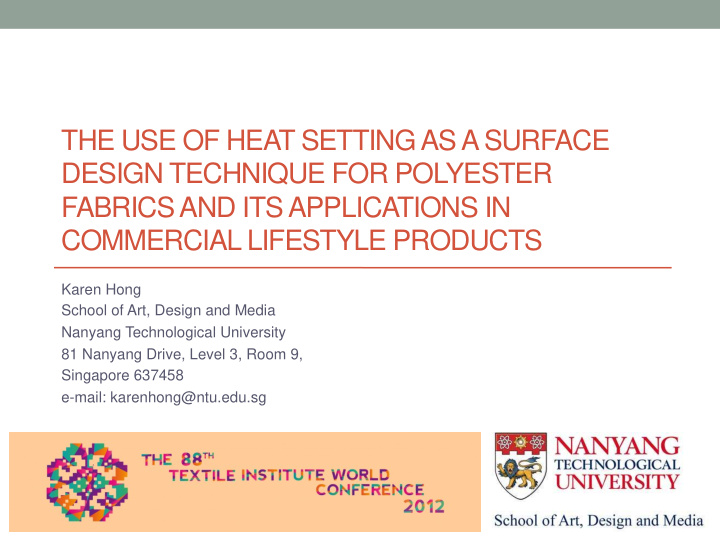



THE USE OF HEAT SETTING AS A SURFACE DESIGN TECHNIQUE FOR POLYESTER FABRICS AND ITS APPLICATIONS IN COMMERCIAL LIFESTYLE PRODUCTS Karen Hong School of Art, Design and Media Nanyang Technological University 81 Nanyang Drive, Level 3, Room 9, Singapore 637458 e-mail: karenhong@ntu.edu.sg
SYNOPSIS This presentation will focus on the use of the heat setting technique on polyester fabrics; with its thermoplastic qualities, polyester fabrics can be pleated and moulded into 3D structural forms. The process of heat setting will be discussed and how these heat set polyester fabrics are further developed into applications within the commercial lifestyle range will be explained. The potential of the heat setting technique, with it’s inherent flexibilities and it’s capacity to be moulded and given a 3D form has created vast possibilities in the area of interior fabrics and products.
WHAT IS HEAT SETTING? Heat setting on fabrics is a technical approach of fabric manipulation that provides a platform into some of the most creative and innovative approaches to surface and textile design. This technique enables a flat fabric to be transformed into structural and sculptural forms. The creative process of pleating, crushing as well as moulding continues to evolve into different possibilities and hence creating this range of interesting surface designs that can be applicable to various creative interiors and lifestyle products.
PLEATING Traditionally, pleats are measured folds formed at the edge of a piece of fabric where they are secured with stitching. Pleating is mainly done by the use of machines with the help of paper pleat patterns to secure the fabric to the desired pleat. Pleating and folding methods varies and each variation of a pleat has been named to distinguish them as specific techniques. The most basic is the accordion pleats; some other variations include box pleats, knife pleats and honeycomb pleats.
CRUSHING Crushing is a more random way of pleating and the creases on the fabric gives an overall random texture and pattern. Stitching on the fabric or gathering of the fabrics can achieve the crushing effect. Crushed fabrics will then pass through heat and pressure; the randomness of the way the fabric is crushed becomes the decorative focus in this fabric.
MOULDING Moulding of the fabric creates structural surfaces on the fabric. Moulds of different shapes and sizes can be used to provide the three-dimensional effect of the fabric. One easy approach is to apply simple ‘shibori’ techniques, by using a binding technique. Once heated, fabric will adhere to the form of the mould, which is below the melting point of the fabric. This creates an amazing textural, rounded and three-dimensional effect to the fabric.
APPLICATIONS The heat set fabrics, with it’s flowing flexibility and softness can be utilized within our interior spaces. These fabrics, being used as cushions, upholsteries, screens, dividers, light shades and wallpapers can determine the ambience of our enclosed space. Interior furnishings and fabrics must be durable, easy to clean and colour fast. These range of heat set fabrics which have been designed into cushions, light shades, screens and dividers have the above mention qualities which makes them suitable to the applications.
Cushions
Light shades
Dividers
Screens
Platform 2012 PLATFORM 2012 is held in conjunction with International Furniture Fair Singapore 2012 / 29th ASEAN Furniture show from 9 - 12 March 2012, located at Singapore Expo.
Recommend
More recommend